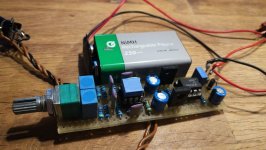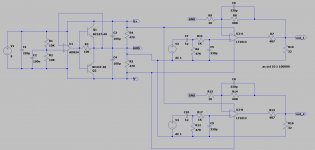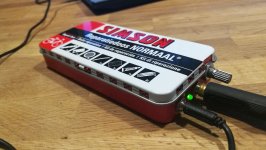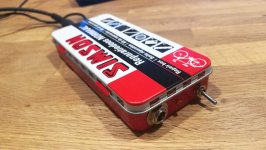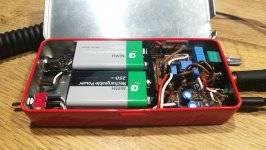Just built a prototype version, nice and small (28x78mm).
Please note that the opamp types in the schematics are not correct, I used LF356 for virtual ground and NE5532 as amplifier.
Also the transistors in the virtual ground circuit are different, I used BD435/436, also you could use BD139/140 or similar.
Last I have added 100nF directly across the powersupply pins of the NE5532 as a piggyback to safe space 🙂
Please note that the opamp types in the schematics are not correct, I used LF356 for virtual ground and NE5532 as amplifier.
Also the transistors in the virtual ground circuit are different, I used BD435/436, also you could use BD139/140 or similar.
Last I have added 100nF directly across the powersupply pins of the NE5532 as a piggyback to safe space 🙂
Attachments
Last edited:
So.. how well does it work ( / measure)? Can't remember seeing an LF356 being used on a single 9V. If you have some NJM4580s floating about, these may also be worth a shot instead of the '5532, as would 4556As.
Gain seems a tad on the high side for something that'll swing 5 Vpp with high-impedance cans on a good day - do you really need an input sensitivity of 200-something mV? You've also done everything to make it less stable (pull down high-frequency gain via 330p, output series resistor inside feedback loop), just saying. (You may find something like a 5p to counteract input capacitance useful though.)
Gain seems a tad on the high side for something that'll swing 5 Vpp with high-impedance cans on a good day - do you really need an input sensitivity of 200-something mV? You've also done everything to make it less stable (pull down high-frequency gain via 330p, output series resistor inside feedback loop), just saying. (You may find something like a 5p to counteract input capacitance useful though.)
Not if you are using it consistently everywhere, including on inputs and outputs. Then the noise effectively is just rail noise and easily suppressed by circuit PSRR.Virtual ground add noise.
So.. how well does it work ( / measure)? Can't remember seeing an LF356 being used on a single 9V. If you have some NJM4580s floating about, these may also be worth a shot instead of the '5532, as would 4556As.
Gain seems a tad on the high side for something that'll swing 5 Vpp with high-impedance cans on a good day - do you really need an input sensitivity of 200-something mV? You've also done everything to make it less stable (pull down high-frequency gain via 330p, output series resistor inside feedback loop), just saying. (You may find something like a 5p to counteract input capacitance useful though.)
The LF356 and NE5532 was something I had laying around, didn't check the spec sheets, but seems to work fine.
I was als thinking about the 4556. Would be nice to test.
Any sugggestions for other usable opamps in the virtual ground curcuit?
I have choosen this gain setting with the option of 2x 9V battery in series for higher impedances.
According your tips I have changed the capacitance in the input circuit to a much lower value (still hoping it will keep some high freq garbage out) and moved the output resistors outside the feedback loop.
By the way it is dead quiet, and immune to picking up noise from mobile phone signals (Very important for a portable device that will be connected to a phone 🙂 )
Now I will search for a nice and small case, maybe a tin box like the altoids ones.
Here in holland we have these tins, might work ok.
Attachments
Last edited:
- Status
- Not open for further replies.
- Home
- Amplifiers
- Headphone Systems
- My take on the CMOY portable headphone amp
